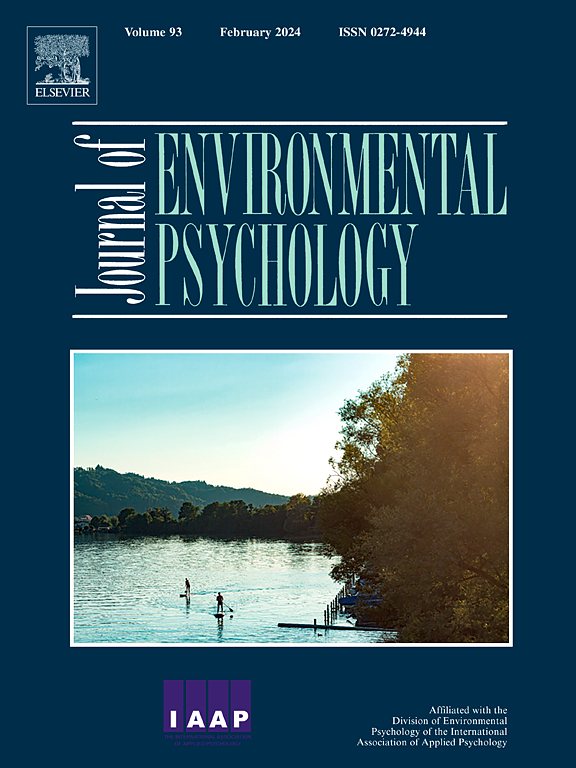人还是熊?性别如何影响不同植被密度水平和不同危险威胁的自然环境体验
IF 7
1区 心理学
Q1 ENVIRONMENTAL STUDIES
引用次数: 0
摘要
感知安全是自然环境中环境体验的一个重要方面。虽然已经确定茂密的植被和危险威胁会阻碍人们对自然环境的安全感知,但相对较少的研究考察了性别在自然访问期间这些特征的环境体验中的作用。与此同时,最近社交媒体上的“男人还是熊”趋势引发了公众的讨论,因为女性似乎更害怕在树林里遇到陌生人而不是熊。本研究旨在探讨性别在自然环境中对危险、恐惧和偏好的感知中的作用,以及它如何与植被密度和不同危险威胁的存在相互作用。它是基于对主要来自英格兰东南部的成年人进行的三项实验。在研究1 (n = 269)和研究2 (n = 414)中,研究人员向参与者展示了不同密度水平的林地幻灯片。我们研究了在三个密度水平(开放、中等和密集)的自然环境中对危险、恐惧和偏好的感知和预期体验,研究2是研究1的复制。研究1和2都表明,女性在自然环境中比男性更容易感到恐惧,更容易感到危险,也更容易表达对危险的担忧。根据影响大小,社会危险成为女性关注的主要问题。研究2还发现,有证据表明,密度对女性的影响比男性更大。在研究3中,300名参与者观看了五种不同的社会和物理危险情景下的林地视频,我们评估了密度和不同危险对恐惧、风险和偏好感知的影响。我们再次发现,女性在所有环境中都感到更害怕,尤其是密集的环境和有社会危险威胁的环境,而男性的经历则不受危险威胁的影响。总的来说,结果表明,女性的自然体验比男性更受安全问题的影响,这些问题与植被密度和危险的存在有关。社会威胁成为女性(但不是男性)享受自然的主要障碍,而且比其他类型的危险(包括动物威胁)重要得多。为了确保普遍积极的自然体验,土地管理者解决这些安全问题至关重要。本文章由计算机程序翻译,如有差异,请以英文原文为准。
Man or bear? How gender affects experiences of natural environments with varying levels of vegetation density and different danger threats
Perceived safety is a crucial aspect of environmental experiences in natural environments. While it is well established that dense vegetation and danger threats can hinder safety perceptions of natural environments, relatively little research has examined the role of gender in environmental experiences of these features during nature visits. In parallel, the recent “Man or bear” trend on social media has sparked conversation among the general public, as it appeared that women are more afraid of encountering a stranger in the woods than a bear. This study aims to explore the role of gender in perceptions of danger, fear and preferences in natural environments and how it may interact with density of vegetation and the presence of different danger threats. It is based on three experiments conducted with adults predominantly from the Southeast of England. In Studies 1 (n = 269) and 2 (n = 414) participants were shown a slide show of woodlands with varying levels of density. We examined perceptions of, and anticipated experiences in perceptions of danger, fear and preferences in natural environments with three levels of density (open, medium, and dense), with Study 2 being a replication of Study 1. Studies 1 and 2 both indicated that women were more likely to experience fear, feel at risk in natural environments than men, and more likely to express concerns about dangers. Based on the effect sizes, social dangers emerged as a key concern for women. Study 2 also found evidence that the effects of density were stronger among women than among men. In Study 3, 300 participants watched videos of woodlands under five different social and physical danger scenarios, and we assessed the impact of density and different dangers on perceptions of fear, risk and preferences. We found, again, that women felt more fearful in all environments, especially dense settings and those with social danger threats, while men's experiences were not impacted by danger threats. Overall, the results indicate that women's experiences of nature can be affected by safety concerns to a larger extent than men's, and that these concerns are related to the density of vegetation and the presence of dangers. Social threats emerged as a key barrier for women's (but not men's) enjoyment of nature, and also significantly more important than other types of dangers, including animal threats. In order to ensure nature experiences which are universally positive, it is crucial for land managers to address these safety concerns.
求助全文
通过发布文献求助,成功后即可免费获取论文全文。
去求助
来源期刊

Journal of Environmental Psychology
Multiple-
CiteScore
10.60
自引率
8.70%
发文量
140
审稿时长
62 days
期刊介绍:
The Journal of Environmental Psychology is the premier journal in the field, serving individuals in a wide range of disciplines who have an interest in the scientific study of the transactions and interrelationships between people and their surroundings (including built, social, natural and virtual environments, the use and abuse of nature and natural resources, and sustainability-related behavior). The journal publishes internationally contributed empirical studies and reviews of research on these topics that advance new insights. As an important forum for the field, the journal publishes some of the most influential papers in the discipline that reflect the scientific development of environmental psychology. Contributions on theoretical, methodological, and practical aspects of all human-environment interactions are welcome, along with innovative or interdisciplinary approaches that have a psychological emphasis. Research areas include: •Psychological and behavioral aspects of people and nature •Cognitive mapping, spatial cognition and wayfinding •Ecological consequences of human actions •Theories of place, place attachment, and place identity •Environmental risks and hazards: perception, behavior, and management •Perception and evaluation of buildings and natural landscapes •Effects of physical and natural settings on human cognition and health •Theories of proenvironmental behavior, norms, attitudes, and personality •Psychology of sustainability and climate change •Psychological aspects of resource management and crises •Social use of space: crowding, privacy, territoriality, personal space •Design of, and experiences related to, the physical aspects of workplaces, schools, residences, public buildings and public space
 求助内容:
求助内容: 应助结果提醒方式:
应助结果提醒方式:


